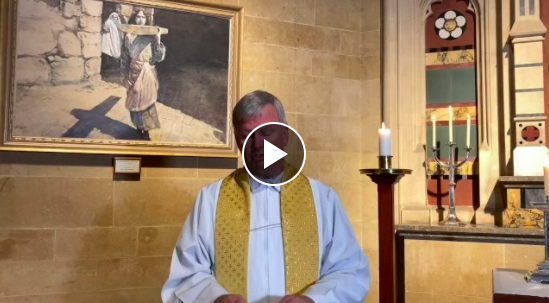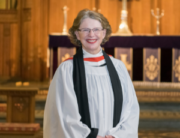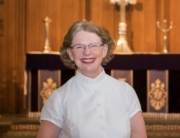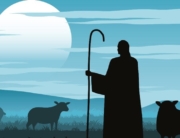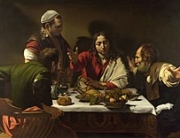Come my way: A sermon by The Very Rev’d Frank Nelson
Acts 7:55-60; Psalm 31:1-5,17-18; 1 Peter 2:11-25; John 14:1-14
Come, my way, my truth, my life: such a way, as gives us breath;
such a truth as ends all strife; such a life, as killeth death.
Come, my light, my feast, my strength: such a light, as shows a feast;
such a feast, as mends in length; such a strength, as makes his guest.
Come, my joy, my love, my heart: such a joy, as none can move;
such a love, as none can part; such a heart, as joys in love.
– George Herbert 1593-1633
There are no prizes for guessing the inspiration for 17th century poet priest George Herbert’s short poem entitled “The Call”. Clearly he had in mind words from today’s Gospel reading when, in response to the disciple Thomas’s puzzlement, Jesus responds: “I am the way, and the truth, and the life.” (John 14:6) This, one of several “I am” sayings by Jesus found in John’s Gospel, is the most profound, inviting us to stay with the ideas, to try and plumb the depth of Jesus’s words, and then to act on them by inviting Jesus into our lives as the way, the truth and the life.
On two occasions that I can recall I have used George Herbert’s poem as the starting point for my preaching – this is the third. That in itself is fitting as threes run thick in the poem. Each of the three verses offers three nouns, metaphors, which describe Christ. The first three come from John 14 and Jesus saying, ‘I am the way, the truth and the life.’ But then Herbert goes off on his own, no doubt drawing on other images and ideas for God from the Bible. So in verse two the invitation is to the one who is ‘my light, my feast, my strength’, and in verse three, in what is a most touching love song, the invitation is to the one who is ‘my joy, my love, my heart.’ Those who enjoy numbers will already have worked out the intricate link with the Trinity – with one commentator putting it this way, “The three-fold structure of the first verse is repeated in the other two; there is a trinity in each verse, and three verses, making a trinity of trinities.” (Richard Watson)
So why focus on this trinity of trinities today? As I recall the first occasion I used the poem in preaching was about 1987. Our second child was about to be born, I was chaplain to a small university and assistant at the local cathedral. Many of the people in the city were in lock-down, living under a strict curfew from sunset to sunrise. Unemployment, hunger, illness was rife through those winter months. No public gatherings were allowed outside – three was deemed a crowd. Vigilante groups roamed the streets at night pursued by heavily armed police and military. From the top of a hill huge searchlights played across the valley, crisscrossing up and down the rows of matchbox houses. The poem spoke to me then, as it does today, of a call to faith and trust in the one who dared to say, I am the way, the truth and the life. It seemed to offer a way through the chaos, the uncertainty, the confusion, the fear.
The second occasion, a few years later, was on Good Friday when I used the poem as the basis for my reflections over a period of three hours. In 1990 the Good Friday three-hour service was well-attended, many people staying for the full time, much of it on their knees. By now the whole country seemed in turmoil, people were afraid to travel by train for fear of being mugged and perhaps killed. Faction fighting between rival gangs and different racial groups was the norm. And the biggest form of ‘entertainment’, if one dares call it that, was the weekly string of funerals – mainly for young people of high school and university age who had been shot by police for protesting against Apartheid. At a time of civil unrest and chaos the call to the One who claimed to be the way, the truth and the life brought a sense of order and calm.
Our world is not one of civil unrest, shootings and crowd violence – at least not in South Australia where we are privileged to live. But it continues to go through one of the greatest periods of turmoil ever experienced on such a large international scale. Two days ago the seventy-fifth anniversary of the end of the Second World was marked in very sober tones. That was the last time when practically the whole world was caught up in suffering and horror. Most of us have little, if any, memory of that. So the shock of the past few weeks and months, and the profound changes enforced on our ‘normal’ way of life, is something we have never experienced before. Some weeks ago we spoke of being in uncharted waters – even that cliché has grown tired and stale – such has been the rate of change. Now, more than ever, we need to hear the call of Christ – the way, the truth and the life. That invitation remains open. We could say it is the Christian’s road map.
On the same day as some in the world marked VE Day our Prime Minister and respective premiers offered us a staged roadmap to the easing of Covid-19 restrictions. South Australia is well-placed to open up fairly quickly. We have been fortunate indeed. But there is no room for complacency; nor will anything like the old ‘normal’ be back soon. Let me take a moment to say something about our Cathedral and its roadmap.
- First – we are not going to act alone. Archbishop Geoff was very clear in his letter to clergy and church leaders on Friday that, and I quote, “a return to ‘normal’ is some time away yet; social distancing and hygiene requirements will continue even as other restrictions lift; and there is continuing need for us all to take responsibility to do what we can to keep safe.”
- Second – the Cathedral is not going to be open tomorrow. In the first instance we need clarity on what is allowed and what is not, what is wise and what is not. How many people could actually safely be in the space, and how will that be monitored and staffed – with most of our Welcomers in a vulnerable age category. And then, the Cathedral is currently a work-site and therefore not ready to be opened safely. There are a good few weeks of work to be done before the scaffolding comes down and the building is cleaned.
- Third – even when numbers are raised again as we enter further opening-up stages we do not yet know what sort of worship we will be able to offer. While we may long to receive communion again – such an important part of our DNA as Anglicans – it seems unlikely that that will be possible any time soon.
Please do not put pressure on clergy and other staff. I can assure you I am as keen as anyone to have the Cathedral doors opened for people to come in to pray and worship God.
And so I find myself wondering if this sort of confused and confusing world we are living in now, where emotions swing this way and that, is anything like that which Thomas and the other disciples faced when Jesus made his “I am” statements. What was it like for the very early church when they witnessed not only Jesus being killed, but Stephen too – the first of many to be called martyrs? Many of the story threads that run through the Bible deal with confusing times, uncertainty, opposition, difficulty. Nowhere is this more clearly seen than in the psalms.
Yet time after time, the great Bible preachers, story-tellers, and those called prophets bring the people back to God who, in today’s psalm (31) is called a rock of refuge, a fortress, a stronghold. It is this God who sent Jesus the Son to become the Saviour of the world. The same Jesus the Son who, when faced with the fear and confusion so well-articulated by Thomas said: “I am the Way, I am the Truth, and I am the Life.”
I love the way that George Herbert turns the invitation around. In the Gospels it is Jesus who calls the disciples to follow him, who invites them to follow Him along the Way. In the poem, which we will hear shortly as a hymn sung by some of our choristers to Alexander Brent Smith’s tune, the invitation goes the other way. The poet invites the one who is the Way, the Truth and the Life to come into his life. May that be our prayer too as we say and sing:
Come, my way, my truth, my life: such a way, as gives us breath;
such a truth as ends all strife; such a life, as killeth death.
Come, my light, my feast, my strength: such a light, as shows a feast;
such a feast, as mends in length; such a strength, as makes his guest.
Come, my joy, my love, my heart: such a joy, as none can move;
such a love, as none can part; such a heart, as joys in love.
– George Herbert 1593-1633

